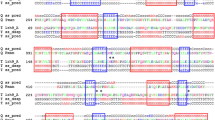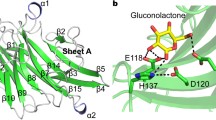Abstract
Here, we present a novel psychrophilic β-glucanase from Glaciozyma antarctica PI12 yeast that has been structurally modeled and analyzed in detail. To our knowledge, this is the first attempt to model a psychrophilic laminarinase from yeast. Because of the low sequence identity (<40 %), a threading method was applied to predict a 3D structure of the enzyme using the MODELLER9v12 program. The results of a comparative study using other mesophilic, thermophilic, and hyperthermophilic laminarinases indicated several amino acid substitutions on the surface of psychrophilic laminarinase that totally increased the flexibility of its structure for efficient catalytic reactions at low temperatures. Whereas several structural factors in the overall structure can explain the weak thermal stability, this research suggests that the psychrophilic adaptation and catalytic activity at low temperatures were achieved through existence of longer loops and shorter or broken helices and strands, an increase in the number of aromatic and hydrophobic residues, a reduction in the number of hydrogen bonds and salt bridges, a higher total solvent accessible surface area, and an increase in the exposure of the hydrophobic side chains to the solvent. The results of comparative molecular dynamics simulation and principal component analysis confirmed the above strategies adopted by psychrophilic laminarinase to increase its catalytic efficiency and structural flexibility to be active at cold temperature.

Structural prediction of a novel laminarinase from the psychrophilic Glaciozyma antarctica PI1ᅟ












Similar content being viewed by others
References
Feller G (2013) Psychrophilic enzymes: from folding to function and biotechnology. Scientifica 2013:1–28
Parvizpour S, Razmara J, Ramli ANM, Rosli MI, Shamsir MS (2014) Structural and functional analysis of a novel psychrophilic β-mannanase from Glaciozyma Antarctica PI12. J Comput-aided Molec Des doi: 10.1007/s10822-014-9751-1
Ilari A, Fiorillo A, Angelaccio S, Florio R, Chiaraluce R, van der Oost J, Consalvi V (2009) Crystal structure of a family 16 endoglucanase from the hyperthermophile Pyrococcus furiosus–structural basis of substrate recognition. FEBS J 276(4):1048–1058
Ahmed R, Jain SK, Shukla PK (2013) modeling and docking studies. Bioinformation 9(16):802–807
G. Fibriansah, S. Masuda, N. Koizumi, S. Nakamura, and T. Kumasaka, “The 1.3 A° crystal structure of a novel endo-β-1,3-glucanase of glycoside hydrolase family 16 from alkaliphilic Nocardiopsis sp. strain F96,” Proteins: Structure, Function, Bioinformatics, no. April, pp. 683–690, 2007
M. L. Sinnott, “Catalytic mechanisms of enzymic glycosyl transfer,” chemical reviews, vol. 90, pp. 1171–1202, 1990
Vasur J, Kawai R, Larsson AM, Igarashi K, Sandgren M, Samejima M, Ståhlberg J (2006) X-ray crystallographic native sulfur SAD structure determination of laminarinase Lam16A lkr n b Phanerochaete chrysosporium. Acta Crystallogr D Biol Crystallogr 62(Pt 11):1422–1429
Vasur J, Kawai R, Andersson E, Igarashi K, Sandgren M, Samejima M, Ståhlberg J (2009) X-ray crystal structures of Phanerochaete chrysosporium Laminarinase 16A in complex with products from lichenin and laminarin hydrolysis. FEBS J 276(14):3858–3869
Vasur J, Kawai R, Jonsson KHM, Widmalm G, Engström A, Frank M, Andersson E, Hansson H, Forsberg Z, Igarashi K, Samejima M, Sandgren M, Ståhlberg J (2010) Synthesis of cyclic beta-glucan using laminarinase 16A glycosynthase mutant from the basidiomycete Phanerochaete chrysosporium. J Am Chem Soc 132(5):1724–1730
Bleicher L, Prates ET, Gomes TCF, Silveira RL, Nascimento AS, Rojas AL, Golubev A, Martínez L, Skaf MS, Polikarpov I (2011) Molecular basis of the thermostability and thermophilicity of laminarinases: X-ray structure of the hyperthermostable laminarinase from Rhodothermus marinus and molecular dynamics simulations. J Phys Chem B 115(24):7940–7949
Altschul SF, Madden TL, Schaffer AA, Zhang J, Zhang Z, Miller W, Lipman DJ (1997) Gapped BLAST and PSI-BLAST: a new generation of protein database search programs. Nucleic Acid Res 25(17):3389–3402
Altschul SF, Gish W, Miller W, Myers EW, Lipman DJ (1990) Basic local alignment search tool. J Mol Biol 215:403–410
Gough J, Karplus K, Hughey R, Chothia C (2001) Assignment of homology to genome sequences using a library of hidden Markov models that represent all proteins of known structure. J Mol Biol 313(4):903–919
Schoonman MJL, Knegtel RMA, Grootenhuis PDJ (1998) Practical evaluation of comparative modelling and threading methods. Comput Chem 22(5):369–375
Söding J, Biegert A, Lupas AN (2005) The HHpred interactive server for protein homology detection and structure prediction. Nucleic Acid Res 33(2):W244–W248
Jones DT (1999) An efficient and reliable protein fold recognition method for genomic sequences. J Mol Biol 287(4):797–815
Kelley LA, Sternberg MJE (2009) Protein structure prediction on the web: a case study using the Phyre server. Nat Protoc 4(3):363–371
Eswar N, Webb B, Marti-Renom M, Madhusudhan MS, Eramian D, Shen M-Y, Pieper U, Sali A (2007) Comparative protein structure modeling using MODELLER. Curr Protoc Bioinform 2(1):1–30
Zhang Y, Skolnick J (2005) TM-align: a protein structure alignment algorithm based on the TM-score. Nucleic Acid Res 33(7):2302–2309
Luthy R, Bowie JU, Eisenberg D (1992) Assessment of protein models with three-dimensional profiles. Nature 356(6364):83–85
Laskowski RA, MacArthur MW, Moss DS, Thornton JM (1993) PROCHECK: a program to check the stereochemical quality of protein structures. J Appl Crystallogr 26(2):283–291
Colovos C, Yeates TO (1993) Verification of protein structures: patterns of nonbonded atomic interactions. Protein Sci 2(9):1511–1519
Papaleo E, Pasi M, Riccardi L, Sambi I, Fantucci P, De Gioia L (2008) Protein flexibility in psychrophilic and mesophilic trypsins. evidence of evolutionary conservation of protein dynamics in trypsin-like serine-proteases. FEBS Lett 582(6):1008–1018
Yang LW, Eya E, Bahar I, Kitao A (2009) Principal component analysis of native ensembles of biomolecular structures (PCA_NEST): insights into functional dynamics. Bioinformatics 25:606–614
CP B, BA H, ME N (2004) Dynamite: a simple way to gain insight into protein motions. Acta Crystallogr D Biol Crystallogr 60:2280–2287
Guex N, Peitsch M (1997) SWISS-MODEL and the Swiss-Pdb viewer: an environment for comparative protein modeling. Electrophoresis 18:2714–2723
Pettersen E, Goddard T, Huang C, Couch G, Greenblatt D, Meng E, Ferrin T (2004) UCSF Chimera–a visualization system for exploratory research and analysis. J Comput Chem 25(13):1605–1612
Corpet F (1988) Multiple sequence alignment with hierarchical clustering. Nucleic Acids Res 16(22):10881–10890
Tamura K, Peterson D, Peterson N, Stecher G, Nei M, Kumar S (2011) MEGA5. molecular evolutionary genetics analysis using maximum likelihood, evolutionary distance, and maximum parsimony methods. Molec Biol Evol 28:2731–2739
Chaitanya M, Babajan B, Anuradha C, Naveen M, Rajasekhar C, Madhusudana P, Kumar C (2010) Exploring the molecular basis for selective binding of Mycobacterium tuberculosis Asp kinase toward its natural substrates and feedback inhibitors: a docking and molecular dynamics study. J Mol Model 16(8):1357–1367
Krah M, Misselwitz R, Politz O, Thomsen KK, Welfle H, Borriss R (1998) The laminarinase from thermophilic eubacterium Rhodothermus marinus–conformation, stability, and identification of active site carboxylic residues by site-directed mutagenesis. Europ J Biochem / FEBS 257(1):101–111
Geralt M, Alimenti C, Vallesi A, Luporini P, Wüthrich K (2013) Thermodynamic stability of psychrophilic and mesophilic pheromones of the protozoan ciliate euplotes. Biology 2(1):142–150
Wallon G, Lovett S, Magyar C, Svingor A, Szilagyi A, Zavodszky P, Ringe D, Petsko G (1997) Sequence and homology model of 3-isopropylmalate dehydrogenase from the psychrotrophic bacterium Vibrio sp. I5 suggest reasons for thermal instability. Protein Eng 10(6):665–672
Davail S, Feller G, Narinx E, Gerday C (1994) Cold adaptation of proteins. purification, characterization, and sequence of the heatlabile subtilisin from the antarctic psychrophile Bacillus TA41. J Biol Chem 269(26):17448–17453
Herning T, Yutani K, Inaka K, Kuroki R, Matsushima M, Kikuchi M (1992) Role of proline residues in human lysozyme stability: a scanning calorimetric study combined with x-ray structure analysis of proline mutants. Biochemistry 31(31):7077–7085
Kumar S, Nussinov R (2004) Different roles of electrostatics in heat and in cold: adaptation by citrate synthase. ChemBioChem 5(3):280–290
Alimenti C, Vallesi A, Pedrini B, Wu¨thrich K, Luporini P (2009) Molecular cold-adaptation: comparative analysis of two homologous families of psychrophilic and mesophilic signal proteins of the protozoan ciliate, Euplotes. IUBMB Life 61(8):838–845
Galkin A, Kulakova L, Ashida H, Sawa Y, Esaki N (1999) Cold adapted alanine dehydrogenases from two Antarctic bacterial strains: gene cloning, protein characterization, and comparison with mesophilic and thermophilic counterparts. Appl Environ Microbiol 65(9):4014–4020
Kim SY, Hwang KY, Kim SH, Sung HC, Han YS, Cho Y (1999) Structural basis for cold adaptation. J Biol Chem 274(17):11761–11767
Zuber H (1988) Temperature adaptation of lactate dehydrogenase structural, functional and genetic aspects. Biophys Chem 29(1–2):171–179
Saunders N, Thomas T, Curmi P, Mattick J, Kuczek E, Slade R, Davis J, Franzmann P, Boone D, Rusterholtz K, Feldman R, Gates C, Bench S, Sowers K, Kadner K, Aerts A, Dehal P, Detter C, Glavina T, Lucas S, Richardson P, Larimer F, Hauser L, Land M, Cavicchioli R (2003) Mechanisms of thermal adaptation revealed from the genomes of the Antarctic Archaea Methanogenium frigidum and Methanococcoides burtonii. Genome Res 13(7):1241–1255
Metpally RPR, Reddy BVB (2009) Comparative proteome analysis of psychrophilic versus mesophilic bacterial species: Insights into the molecular basis of cold adaptation of proteins. BMC Genomics 10:11
Kumar S, Nussinov R (2002) Close-range electrostatic interactions in proteins. ChemBioChem 3(7):604–617
Jarvis R, Patrick E (1973) Clustering using a similarity measure based on shared near neighbors. IEEE Trans Comput 11:1025–1034
Author information
Authors and Affiliations
Corresponding author
Rights and permissions
About this article
Cite this article
Parvizpour, S., Razmara, J., Jomah, A.F. et al. Structural prediction of a novel laminarinase from the psychrophilic Glaciozyma antarctica PI12 and its temperature adaptation analysis. J Mol Model 21, 63 (2015). https://doi.org/10.1007/s00894-015-2617-1
Received:
Accepted:
Published:
DOI: https://doi.org/10.1007/s00894-015-2617-1




